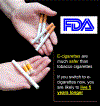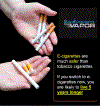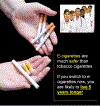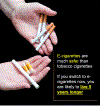Information and sin goods: Experimental evidence on cigarettes
- PMID: 33220157
- PMCID: PMC8312502
- DOI: 10.1002/hec.4189
Information and sin goods: Experimental evidence on cigarettes
Abstract
We test the importance of information source on consumer choice in the context of sin goods, specifically electronic and tobacco cigarettes, among adult smokers. We proxy choice with intentions to vape and quit smoking in the next 30 days. We experimentally vary the information source: government, private companies, physicians, and no source. Our findings suggest that information source matters in the context of cigarettes choice for adult smokers. Private companies appear to be an important information source for cigarettes among adult smokers.
Keywords: choice; electronic cigarettes; experiments; information; signaling; sin goods; smoking.
© 2020 John Wiley & Sons Ltd.
Figures







Similar articles
-
Smokers' behavioral intentions in response to a low-nicotine cigarette policy.Drug Alcohol Depend. 2019 Dec 1;205:107645. doi: 10.1016/j.drugalcdep.2019.107645. Epub 2019 Oct 18. Drug Alcohol Depend. 2019. PMID: 31704376
-
Health Professionals' Counseling about Electronic Cigarettes for Smokers and Vapers in a Country That Bans the Sales and Marketing of Electronic Cigarettes.Int J Environ Res Public Health. 2020 Jan 9;17(2):442. doi: 10.3390/ijerph17020442. Int J Environ Res Public Health. 2020. PMID: 31936477 Free PMC article.
-
Smoking cessation among US adults: use of e-cigarettes, including JUUL, and NRT use.Tob Control. 2021 Nov;30(6):693-695. doi: 10.1136/tobaccocontrol-2020-056013. Epub 2020 Sep 21. Tob Control. 2021. PMID: 32958602
-
Public Health Policies on E-Cigarettes.Curr Cardiol Rep. 2019 Aug 28;21(10):111. doi: 10.1007/s11886-019-1204-y. Curr Cardiol Rep. 2019. PMID: 31463564 Free PMC article. Review.
-
Systematic review of changed smoking behaviour, smoking cessation and psychological states of smokers according to cigarette type during the COVID-19 pandemic.BMJ Open. 2022 Jun 14;12(6):e055179. doi: 10.1136/bmjopen-2021-055179. BMJ Open. 2022. PMID: 35701057 Free PMC article.
Cited by
-
Can social media encourage diabetes self-screenings? A randomized controlled trial with Indonesian Facebook users.NPJ Digit Med. 2024 Sep 13;7(1):245. doi: 10.1038/s41746-024-01246-x. NPJ Digit Med. 2024. PMID: 39271847 Free PMC article.
-
Who, me? Optimism bias about US teenagers' ability to quit vaping.Addiction. 2021 Nov;116(11):3180-3187. doi: 10.1111/add.15525. Epub 2021 May 8. Addiction. 2021. PMID: 33891783 Free PMC article.
References
-
- Abadie A, Athey S, Imbens GW, & Wooldridge J (2017). When should you adjust standard errors for clustering? (Tech. Rep. No. 24003). National Bureau of Economic Research.
-
- Ajzen I (1991). The theory of planned behavior. Organizational Behavior and Human Decision Processes, 50(2), 179–211.
-
- Allen JG, Flanigan SS, LeBlanc M, Vallarino J, MacNaughton P, Stewart JH, & Christiani DC (2016). Flavoring chemicals in e-cigarettes: diacetyl, 2, 3-pentanedione, and acetoin in a sample of 51 products, including fruit-, candy-, and cocktail-flavored e-cigarettes. Environmental Health Perspectives, 124(6), 733. - PMC - PubMed
-
- American Academy of Arts and Sciences. (2018). The Public Face of Science: Perceptions of Science in America (Tech. Rep.) American Academy of Arts and Sciences. Retrieved from https://www.amacad.org/content/publications/publication.aspx?d=43055
-
- Angrist JD, & Pischke J-S (2009). Mostly harmless econometrics: An empiricist’s companion Princeton University Press.
Publication types
MeSH terms
Grants and funding
LinkOut - more resources
Full Text Sources
Medical

